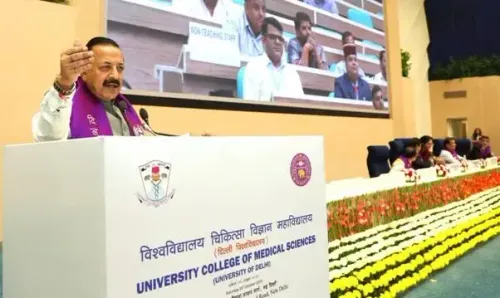Will India Become the 4th Largest Economy and Boost Manufacturing and MedTech?

Synopsis
Key Takeaways
- India is set to become the fourth-largest economy by 2025, surpassing Japan.
- Projected GDP of $4.19 trillion will enhance global competitiveness.
- Per capita income expected to double to $2,880.
- Significant boost for indigenous manufacturing and medical technology.
- Focus on inclusive growth and improved living standards is crucial.
New Delhi, May 27 (NationPress) As India approaches the significant milestone of becoming the world's fourth-largest economy, this achievement is anticipated to enhance the nation's manufacturing and medical technology sectors, as stated by the Association of Indian Medical Device Industry (AiMeD) on Tuesday.
On Monday, NITI Aayog announced that by the end of 2025, India is poised to surpass Japan and claim the position of the fourth-largest economy globally.
The International Monetary Fund (IMF) in its April World Economic Outlook (WEO) report projected that India is expected to reach a GDP of $4.19 trillion by 2025, ahead of Japan.
According to Rajiv Nath, Forum Coordinator of AiMeD, this progress will significantly enhance domestic manufacturing and self-sufficiency in the medical devices sector.
“A thriving economy enables us to expand R&D efforts, invest in innovative technologies, and enhance our competitiveness on a global scale,” Nath remarked.
“Being recognized as a leading economy will boost investor confidence, foster international collaborations, and position Indian manufacturers to excel not just in volume but also in innovation and quality,” he elaborated.
The IMF's April WEO highlighted that India's GDP for the complete year of 2025 is projected to surpass that of Japan.
IMF data indicates that India's per capita income is set to rise to $2,880 in 2025, up from $1,438 in 2013-14.
The nominal GDP for 2025 (FY26) is forecasted to be $4.187 trillion, slightly exceeding Japan's estimated $4.186 trillion, according to the IMF.
Nath described this achievement as a moment of great national pride and international recognition, marking India's evolution from an emerging economy to a global economic powerhouse.
“Japan has long represented industrial excellence and discipline; surpassing such a robust economy reflects India's growing economic maturity, expanding influence, and its vital role in shaping global narratives. This is not merely about numbers—it's about momentum, demographic strength, and the immense untapped potential of India's youthful and dynamic population,” Nath stated.
He also emphasized the importance of focusing on improving per capita income, enhancing living standards, and fostering inclusive growth.
“It is crucial that this economic advancement results in tangible benefits at the grassroots level, benefiting both rural and urban India,” he concluded.









